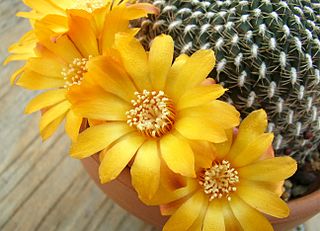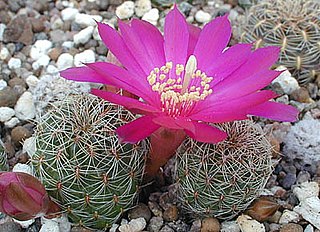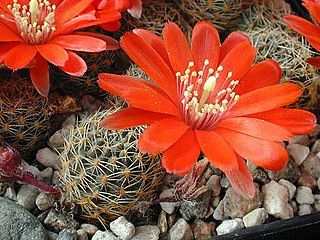
Cephalocereus senilis, the old man cactus, is a species of cactus native to Guanajuato and Hidalgo in eastern Mexico. It is threatened in the wild, but widespread propagation and popularity in cultivation have reduced the demand on wild populations.

Opuntia microdasys is a species of flowering plant in the cactus family Cactaceae, native and endemic to central and northern Mexico.

Eriosyce is a genus of cacti native to Chile.

Echinocactus grusonii, popularly known as the golden barrel cactus, golden ball or mother-in-law's cushion, is a well known species of cactus, and is endemic to east-central Mexico.

Ferocactus viridescens is a species of flowering plant in the cactus family Cactaceae. This rare barrel cactus is known by several common names, including coast barrel cactus, keg cactus and San Diego barrel cactus. Most of its native range is in San Diego County, California, where it is threatened by development, agriculture, and other alterations in its habitat. It is also found in northern Baja California, Mexico.

Mammillaria elongata, the gold lace cactus or ladyfinger cactus, is a species of flowering plant in the family Cactaceae, native to central Mexico. Growing to 15 cm (6 in) tall by 30 cm (12 in) wide, it consists of densely packed clusters of elongated oval stems, covered in harmless yellow or brown spines, and in spring producing white or yellow flowers. It is among the commonest and most variable of its genus in nature, and is a popular subject for cultivation. It has gained the Royal Horticultural Society's Award of Garden Merit.

Schlumbergera gaertneri, formerly Hatiora gaertneri, is a species of epiphytic cactus which belongs to the tribe Rhipsalideae within the subfamily Cactoideae of the Cactaceae. Together with the hybrid with S. rosea, Schlumbergera × graeseri, it is known as Easter cactus or Whitsun cactus and is a widely cultivated ornamental plant. It has received the Royal Horticultural Society's Award of Garden Merit.

Gymnocalycium quehlianum, the Quehla chin cactus, is a species of flowering plant in the family Cactaceae, native to northern Argentina.

Mammillaria geminispina, the twin spined cactus, is a species of flowering plant in the family Cactaceae, native to central Mexico. It grows to 25 cm (10 in) tall by 50 cm (20 in) broad. The clustering spherical stems, 8 cm in diameter, are covered in white down and white spines. Carmine pink flowers are borne in summer and autumn.

Echinopsis subdenudata is a species of cactus. It has a globular shape, few spines, with large, white flowers attached to long, green tubes. It occurs in Bolivia, at altitudes of 600–1800 metres. Under its synonym Echinopsis ancistrophora it has gained the Royal Horticultural Society's Award of Garden Merit.

Copiapoa hypogaea, the underground copiapoa, is a species of flowering plant in the genus Copiapoa in the cactus family (Cactaceae), native to northern Chile. It has gained the Royal Horticultural Society's Award of Garden Merit.

Pilosocereus leucocephalus, called old man cactus, old man of Mexico, tuno, and woolly torch, is a species of cactus in the genus Pilosocereus, native to Mexico and Central America. It has gained the Royal Horticultural Society's Award of Garden Merit.

Matucana intertexta is a species of cactus in the genus Matucana, native to Peru. It has gained the Royal Horticultural Society's Award of Garden Merit.

Rebutia arenacea, the arenaceous crown cactus, is a species of cactus in the genus Rebutia, native to central Bolivia. It has gained the Royal Horticultural Society's Award of Garden Merit.

Rebutia canigueralii is a species of cactus in the genus Rebutia, native to Bolivia. It has gained the Royal Horticultural Society's Award of Garden Merit.

Rebutia mentosa, the crown cactus, is a species of cactus in the genus Rebutia, native to Bolivia. It has gained the Royal Horticultural Society's Award of Garden Merit.

Rebutia neocumingii, the Cuming crown cactus, is a species of cactus in the genus Rebutia, native to Bolivia and Peru. It has gained the Royal Horticultural Society's Award of Garden Merit.

Rebutia pulvinosa is a species of cactus in the genus Rebutia, native to Bolivia. Two of its subspecies, Rebutia pulvinosa subsp. albiflora and Rebutia pulvinosa subsp. perplexa, have gained the Royal Horticultural Society's Award of Garden Merit.

Rebutia pygmaea is a species of cactus in the genus Rebutia, native to Bolivia and northwest Argentina. It has gained the Royal Horticultural Society's Award of Garden Merit.

Rebutia steinbachii, called Steinbach's crown cactus, is a species of cactus in the genus Rebutia, native to Bolivia. It has gained the Royal Horticultural Society's Award of Garden Merit.




















